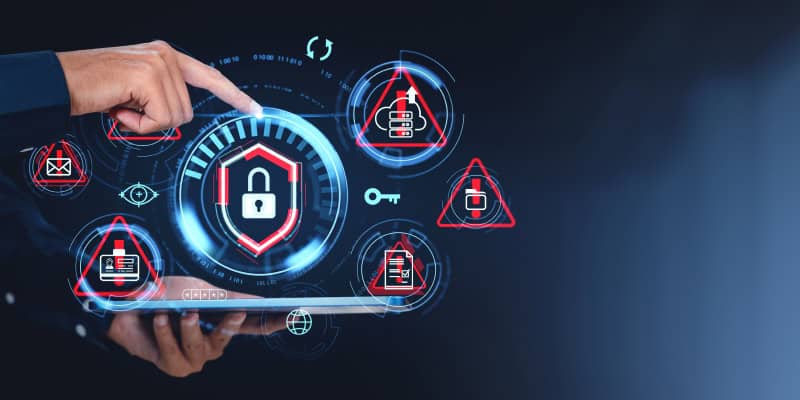Amidst today’s digital challenges, businesses face numerous cybersecurity threats. At the forefront is phishing, with phishing stats in 2024 highlighting a troubling trend: an escalation in both the sophistication and targeting of these attacks. Understanding these evolving threats is crucial for protecting your vital assets and sensitive data with cybersecurity services.
This article thoroughly examines the latest phishing statistics for 2024, revealing key trends and their implications across various sectors. With this knowledge, you can bolster your defenses against these cyber threats.
2024 Key Phishing Trends and Statistics
Phishing, a deceptive crime that tricks individuals into sharing sensitive data or installing malware, does not discriminate by industry. It casts a broad net, impacting various sectors due to the value of the information they hold.
Recent statistics highlight the severity and rapid evolution of phishing threats:
1. A notable global increase of 393% emphasizes the severity of the phishing threat.
2. Cybercriminals are advancing and using sophisticated technologies like AI to craft hard-to-detect attacks.
3. Corporate phishing stats reveal an alarming pattern, with 94% of organizations reporting incidents.
4. The rapidity of these attacks is concerning:
- Users may click on phishing links within 21 seconds.
- Users can submit sensitive data in under 28 seconds.
Vigilance and awareness are essential in combating increasingly sophisticated phishing threats.
Regional Phishing Landscape
Let us examine the phishing statistics in critical regions in 2023 and 2024—USA, Brazil, and India—highlighting their unique challenges and trends.
USA: Financial Impact
- In the US, phishing accounts for 36% of all data breaches in 2023, with significant financial implications.
- The FBI Internet Crime Complaint Center (IC3) reported losses exceeding $2.9 trillion in 2023 from Business Email Compromise (BEC) attacks alone.
Brazil: Phishing Domains
- Brazil has 3,589 potential phishing domains registered in 2023, impersonating local organizations.
- The financial and pharmaceutical sectors have seen a slight cost decrease, indicating a shift in the phishing landscape.
India: High Vulnerability
- India is the third most targeted country globally and the most targeted in Asia, with 300 million vulnerable people.
- Only about 7% of scam victims (Mobile World Congress Barcelona, 2021) report incidents to authorities, highlighting the vast scale of phishing in India and its challenges.
Addressing phishing requires global cooperation and increased vigilance.
Modern Phishing Attack Methods
Let us explore the most common forms of phishing attacks, each with its own approach and sophistication level.
Email Phishing
Email phishing employs psychological tactics to create urgency, fear, or curiosity. It often impersonates important figures like CEOs and promises unexpected rewards.
Recognizing signs of phishing emails, such as generic greetings, spelling errors, and suspicious links, can significantly reduce the risk of falling victim. Additionally, implementing Multi-Factor Authentication (MFA) and regular security training for employees can further protect sensitive information.
Spear Phishing
Spear phishing is a sophisticated, targeted attack where attackers carefully research and craft personalized messages for specific individuals or organizations, increasing the likelihood of success.
By mining social media profiles, company sites, and public sources for personal details, professional roles, and data, attackers create messages or emails that appear legitimate and relevant, increasing the probability that the recipient will engage with the malicious content. This makes high-profile individuals and organizations prime targets due to their valuable data or potential for financial manipulation.
AI-Generated Phishing
AI-generated phishing attacks utilize tools like ChatGPT to create convincingly personalized emails that bypass traditional detection methods. One concerning application is deepfake technology, which allows attackers to impersonate individuals with high accuracy through hyperrealistic audio and video manipulations, making messages or video calls appear to come from trusted sources.
In response to these challenges, businesses are turning to advanced AI-driven security solutions that analyze vast data to identify subtle signs of phishing attempts. However, the ongoing arms race between cybercriminals and cybersecurity professionals continues, with each advancement in defense prompting an innovation in attack methods.
Impact on Industries and Economic Consequences
Phishing attacks have far-reaching effects that jeopardize both industry stability and the global economy.
Industry Impact
Phishing attacks broadly impact sectors like healthcare, targeting valuable medical data, and social media platforms with vast user bases. These attacks pose significant threats to financial and operational stability across industries.
Healthcare Sector Vulnerabilities
Healthcare institutions face immediate financial burdens from responding to breaches and the long-term consequences of compromised patient data. If medical records are altered or misused, it can lead to a loss of trust among patients and life-threatening situations.
Financial Sector Risks
Financial institutions are prime targets for cybercriminals, who employ highly personalized tactics to deceive employees and customers into divulging sensitive information. The repercussions include economic loss, breach of consumer confidence, and stringent regulatory penalties. Additionally, phishing attacks can lead to operational disruptions, data loss, costly recovery efforts, and damage to reputation.
As we explore the nuances of cybersecurity, it becomes clear that the fight against phishing is not just a technical challenge but a comprehensive business imperative.
Global Economic Impact
The economic impact of phishing attacks is profound. They affect the immediate financial standing of businesses and consumers while inflicting long-term damage on corporate reputations and consumer trust.
- The FBI’s IC3 reported losses exceeding $10.3 billion in 2022 due to phishing scams.
- The average cost of a phishing attack for businesses is estimated at $4.45 million, including the expenses of responding to and recovering from an attack.
- BEC attacks have led to record losses—$2.9 trillion (FBI report). These attacks highlight the advanced tactics cybercriminals use to deceive employees into making unauthorized transfers or divulging sensitive information.
Addressing phishing is essential for safeguarding businesses and consumers alike.
Strengthen Your Phishing Defenses With CMIT
As we have explored the latest phishing stats and trends, it is evident that the threat landscape is constantly evolving. Staying vigilant is essential in this environment.
Implementing robust cybersecurity strategies is highly crucial. CMIT Solutions in Mesa offers tailored cybersecurity services, including:
- Continuous employee training to enhance security awareness.
- Advanced email security solutions to detect and prevent phishing.
- AI-driven tools for real-time threat detection.
- Unified cybersecurity platforms for comprehensive protection.
Get started with our expert IT consulting and fortify your business against the risks highlighted in today’s phishing statistics. Your cybersecurity is our top priority!
Our IT Services
| Managed IT Services | Cybersecurity | Productivity Applications |
| IT Support | Cloud Services | Network Management |
| Compliance | Data Backup | Unified Communications |
| IT Guidance | IT Procurement |




